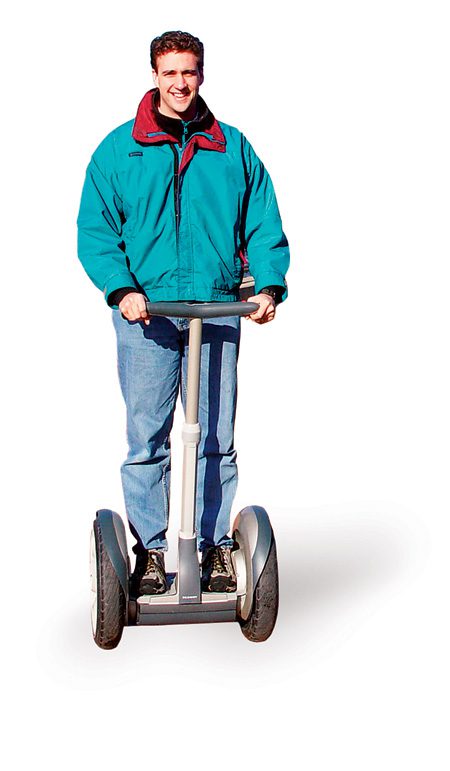By A.K. Stewart, ‘91

LUCKILY, David W. Robinson, ’94, is a man who can keep a secret. Robinson was instrumental in the creation of the Segway human transport. Otherwise known as “It,” the high-tech motorized scooter was unveiled across the country in late 2001 amid much media hype and keen interest from those in technology fields.
Keeping the invention under wraps for almost two years was not easy for this engineering whiz, who grew up in Provo. “I told my parents nothing. All they knew was I worked in New Hampshire,” says Robinson, who is employed at Segway LLC, a spin-off of DEKA Research and Development in Manchester, N.H.
“We asked David several times what he was working on and he always avoided the question,” says his father, Donald W. Robinson, a BYU emeritus professor of mathematics.
David Robinson’s wife, Sarah Moody Robinson, from Orem, had to sign a disclosure agreement with Segway promising to keep mum. Sarah says she had no problem keeping her husband’s work a secret.
“There was so much riding on it,” she explains.
“She never slipped up,” David says.
All the secrecy came to an end with the much-anticipated announcement in early December. The motorized scooter may represent a revolution in transportation, using computer processors to imitate human balance and to monitor the user’s center of gravity.
Robinson became involved with Segway after receiving mechanical engineering degrees from BYU (bachelor’s) and the Massachusetts Institute of Technology (master’s and doctoral). He then began seeking employment in his field.
The interviewing process with Segway officials was interesting since they couldn’t tell him exactly what he would be working on, says Segway marketing director Tobe Cohen. “We were in stealth mode,” he says.
Robinson works in the dynamics group, which developed the algorithms for the Segway. He has discovered in his field that if he’s stuck on a problem, it’s best to break away for a while.
So he runs along the Merrimack River. Or he goes to the YMCA and works out during his lunch hour. Or he heads home and cooks homemade burritos and nachos for his two daughters, Hannah, 5, and MaryAnn, 2. Then when Robinson gets back to his office, he usually has the problem figured out.
The job is extremely rewarding, Robinson says. “It’s been a nice mixture of discovery as well as execution and being able to see a finished product.”
The unveiling of the invention was a glorious moment for Robinson and the rest of the Segway team. “It was exciting to let the world see it,” Robinson says. “And it was a huge release for me to be able to speak to my family and friends about what I actually do at work.”
And they are excited to hear about it.
“David has a great gift for math and mechanics,” says his father, who became aware of his son’s talent when David was 10 and picked up his first Rubik’s Cube puzzle.
“I watched in amazement as, in less than two minutes, he returned the completed puzzle to a very stunned salesman,” Donald Robinson says. “I was flabbergasted just watching.”
Although the Segway has been unveiled, there’s still plenty of work to do at the company, David Robinson says. “I won’t be twiddling my thumbs. There is still a lot to be learned about the Segway. This is just the beginning of this company.”?—A.K. Stewart, ’91
www.segway.com









